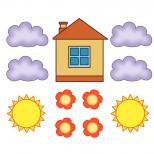What is the limited function definition. Limits of monotone functions. Lesson and presentation on the topic: "Properties of a function. Function increase and decrease"
Note that all definitions include a numeric set X, which is part of the domain of the function: X with D(f). In practice, most often there are cases when X is a numerical interval (segment, interval, ray, etc.).
Definition 1.
A function y \u003d f (x) is called increasing on a set X with D (f) if for any two points x 1 and x 2 of the set X such that x 1< х 2 , выполняется неравенство f(х 1 < f(х 2).
Definition 2.
A function y \u003d f (x) is called decreasing on a set X with D (f) if for any monotonicity of two points x 1 and x 2 of the set X, such that x 1< х 2 , функции выполняется неравенство f(x 1) >f(x2).
In practice, it is more convenient to use the following formulations: the function increases if the larger value of the argument corresponds to the larger value of the function; the function is decreasing if the larger value of the argument corresponds to the smaller value of the function.
In the 7th and 8th grades, we used the following geometric interpretation of the concepts of increasing or decreasing functions: moving along the graph of an increasing function from left to right, we sort of climb up the hill (Fig. 55); moving along the graph of a decreasing function from left to right, as if we were going down a hill (Fig. 56).
Usually the terms “increasing function”, “decreasing function” are united by the common name monotonic function, and the study of a function for increasing or decreasing is called the study of a function for monotonicity.
We note one more circumstance: if a function is increasing (or decreasing) in its natural domain of definition, then it is usually said that the function is increasing (or decreasing) - without specifying the numerical set X.
Example 1
Examine the function for monotonicity:
a) y \u003d x 3 + 2; b) y \u003d 5 - 2x.
Solution:
a) Take arbitrary values of the argument x 1 and x 2 and let x 1<х 2 . Тогда, по свойствам числовых неравенств (мы с вами изучали их в курсе алгебры 8-го класса), будем иметь:

The last inequality means that f(x 1)< f(х 2). Итак, из х 1 < х 2 следует f{х 1) < f(х 2), а это означает, что заданная функция возрастает (на всей числовой прямой).
So from x 1< х 2 следует f(х 1) >f(x 2), which means that the given function is decreasing (on the entire number line).
Definition 3.
The function y - f(x) is called bounded from below on the set X with D (f) if all the values of the function on the set X are greater than a certain number (in other words, if there is a number m such that for any value x є X the inequality f( x) >m).
Definition 4.
The function y \u003d f (x) is called bounded from above on the set X with D (f) if all values of the function are less than a certain number (in other words, if there is a number M such that for any value x є X the inequality f (x)< М).
If the set X is not specified, then it is assumed that the function is bounded from below or from above in the entire domain of definition.
If a function is bounded both from below and from above, then it is called bounded.
The boundedness of a function is easily read from its graph: if the function is bounded from below, then its graph is entirely located above some horizontal line y \u003d m (Fig. 57); if the function is bounded from above, then its graph is entirely located below some horizontal line y \u003d M (Fig. 58).

Example 2 Investigate a function for boundedness
Solution. On the one hand, the inequality is quite obvious (by the definition of a square root, this means that the function is bounded from below. On the other hand, we have and therefore
This means that the function is bounded from above. Now look at the graph of the given function (Fig. 52 from the previous paragraph). The boundedness of the function both from above and from below is read quite easily from the graph.
Definition 5.
The number m is called the smallest value of the function y \u003d f (x) on the set X C D (f), if:
1) in X there is such a point x 0 that f(x 0) = m;
2) for all x from X the inequality m>f(х 0) is fulfilled.
Definition 6.
The number M is called the largest value of the function y \u003d f (x) on the set X C D (f), if:
1) in X there is such a point x 0 that f(x 0) = M;
2) for all x from X, the inequality
We denoted the smallest value of the function both in the 7th and 8th grades by the symbol y, and the largest value by the symbol y.
If the set X is not specified, then it is assumed that we are talking about finding the smallest or largest value of the function in the entire domain of definition.
The following useful statements are quite obvious:
1) If a function has Y, then it is bounded from below.
2) If a function has Y, then it is bounded from above.
3) If the function is not bounded below, then Y does not exist.
4) If the function is not bounded from above, then Y does not exist.
Example 3
Find the smallest and largest values of a function
Solution.
It is quite obvious, especially if you resort to the function graph (Fig. 52), that \u003d 0 (the function reaches this value at the points x \u003d -3 and x \u003d 3), a \u003d 3 (the function reaches this value at the point x \u003d 0.
In 7th and 8th grade, we mentioned two more properties of functions. The first was called the convexity property of a function. It is considered that a function is convex downward on the interval X if, by connecting any two points of its graph (with abscissas from X) with a straight line segment, we find that the corresponding part of the graph lies below the drawn segment (Fig. 59). continuity A function is convex upward on the interval X if, by connecting any two points of its graph (with abscissas from X) by a straight line segment, we find that the corresponding part of the graph lies above the drawn segment (Fig. 60).

The second property - the continuity of the function on the interval X - means that the graph of the function on the interval X is continuous, i.e. has no punctures and jumps.
Comment.
In fact, in mathematics, everything is, as they say, “exactly the opposite”: the graph of a function is depicted as a solid line (without punctures and jumps) only when the continuity of the function is proved. But the formal definition of the continuity of a function, which is quite complex and subtle, is beyond our powers yet. The same can be said about the convexity of a function. Discussing these two properties of functions, we will continue to rely on visual-intuitive representations.
Now let's review our knowledge. Remembering the functions that we studied in the 7th and 8th grades, we will clarify how their graphs look and list the properties of the function, adhering to a certain order, for example: domain of definition; monotone; limitation; , ; continuity; range of values; convex.
Subsequently, new properties of functions will appear, and the list of properties will change accordingly.
1. Constant function y \u003d C
The graph of the function y \u003d C is shown in fig. 61 - straight line, parallel to the x-axis. This is such an uninteresting function that it makes no sense to list its properties.

The graph of the function y \u003d kx + m is a straight line (Fig. 62, 63).

Properties of the function y \u003d kx + m:
1) ![]()
2) increases if k > 0 (Fig. 62), decreases if k< 0 (рис. 63);
4) there is neither the largest nor the smallest values;
5) the function is continuous;
6) ![]()
7) it makes no sense to talk about convexity.
The graph of the function y \u003d kx 2 is a parabola with a vertex at the origin and with branches directed upwards if k\u003e O (Fig. 64), and downwards if k< 0 (рис. 65). Прямая х = 0 (ось у) является осью параболы.

Properties of the function y - kx 2:
For the case k > 0 (Fig. 64):
1) D(f) = (-oo,+oo);
4) = does not exist;
5) continuous;
6) Е(f) = the function decreases, and on the interval , decreases on the ray;
7) convex upwards.
The graph of the function y \u003d f (x) is built point by point; the more points of the form (x; f (x)) we take, the more accurate idea of the graph we get. If we take a lot of these points, then the idea of the graph will be more complete. It is in this case that intuition tells us that the graph should be drawn as a solid line (in this case, as a parabola). And then, reading the graph, we draw conclusions about the continuity of the function, about its convexity downwards or upwards, about the range of the function. You must understand that of the listed seven properties, only properties 1), 2), 3), 4) are "legal" in the sense that we are able to substantiate them by referring to precise definitions. We have only visual-intuitive representations about the remaining properties. By the way, there's nothing wrong with that. From the history of the development of mathematics, it is known that mankind often and for a long time used various properties of certain objects, not knowing the exact definitions. Then, when such definitions could be formulated, everything fell into place. ![]()
The graph of the function is a hyperbola, the coordinate axes serve as asymptotes of the hyperbola (Fig. 66, 67).

1) D(f) = (-00.0)1U (0.+oo);
2) if k > 0, then the function decreases on the open ray (-oo, 0) and on the open ray (0, +oo) (Fig. 66); if to< 0, то функция возрастает на (-оо, 0) и на (0, +оо) (рис. 67);
3) is not limited either from below or from above;
4) there is neither the smallest nor the largest values;
5) the function is continuous on the open ray (-oo, 0) and on the open ray (0, +oo);
6) E(f) = (-oo, 0) U (0, + oo);
7) if k > 0, then the function is convex upwards at x< 0, т.е. на открытом луче (-оо, 0), и выпукла вниз при х >0, i.e. on the open beam (0, +oo) (Fig. 66). If to< 0, то функция выпукла вверх при х >o and convex down at x< О (рис. 67).
The graph of the function is a branch of the parabola (Fig. 68). Function Properties :
1) D(f) = , increases on the ray. On this segment $16-x^2≤16$ or $\sqrt(16-x^2)≤4$, but this means boundedness from above.
Answer: our function is limited by two lines $y=0$ and $y=4$.
Highest and lowest value
The smallest value of the function y= f(x) on the set Х⊂D(f) is some number m, such that:
b) For any xϵX, $f(x)≥f(x0)$ holds.
The greatest value of the function y=f(x) on the set Х⊂D(f) is some number m, such that:
a) There is some x0 such that $f(x0)=m$.
b) For any xϵX, $f(x)≤f(x0)$ is satisfied.
The largest and smallest value is usually denoted by y max. and y name. .
The concepts of boundedness and the largest with the smallest value of a function are closely related. The following statements are true:
a) If there is a smallest value for a function, then it is bounded from below.
b) If there is a maximum value for a function, then it is bounded from above.
c) If the function is not bounded from above, then there is no maximum value.
d) If the function is not bounded below, then the smallest value does not exist.
Find the largest and smallest value of the function $y=\sqrt(9-4x^2+16x)$.
Solution: $f(x)=y=\sqrt(9-4x^2+16x)=\sqrt(9-(x-4)^2+16)=\sqrt(25-(x-4)^2 )≤5$.
For $x=4$ $f(4)=5$, for all other values, the function takes smaller values or does not exist, that is, this is the largest value of the function.
By definition: $9-4x^2+16x≥0$. Find the roots of the square trinomial $(2x+1)(2x-9)≥0$. At $x=-0.5$ and $x=4.5$ the function vanishes, at all other points it is greater than zero. Then, by definition, the smallest value of the function is zero.
Answer: y max. =5 and y min. =0.
Guys, we have also studied the concepts of convexity of a function. When solving some problems, we may need this property. This property is also easily determined using graphs.
The function is convex down if any two points of the graph of the original function are connected, and the graph of the function is below the line connecting the points.
The function is convex upward if any two points of the graph of the original function are connected, and the graph of the function is above the line connecting the points.

A function is continuous if the graph of our function has no discontinuities, such as the graph of the function above.
If you want to find the properties of a function, then the sequence of searching for properties is as follows:
a) Domain of definition.
b) Monotony.
c) limitation.
d) The largest and smallest value.
e) Continuity.
f) Range of values.
Find the properties of the function $y=-2x+5$.
Solution.
a) Domain of definition D(y)=(-∞;+∞).
b) Monotony. Let's check for any values x1 and x2 and let x1< x2.
$f(x1)=-2x1+2$.
$f(x2)=-2x2+2$.
Because x1< x2, то f(x1) < f(x2), то есть большему значению аргумента, соответствует меньшее значение функции. Функция убывает.
c) limitation. Obviously, the function is not limited.
d) The largest and smallest value. Since the function is not bounded, there is no maximum or minimum value.
e) Continuity. The graph of our function has no gaps, then the function is continuous.
f) Range of values. E(y)=(-∞;+∞).
Tasks on the properties of a function for independent solution
Find function properties:a) $y=2x+7$,
b) $y=3x^2$,
c) $y=\frac(4)(x)$.
We will call the function y=f(x) BOUNDED UP (BOTTOM) on the set A from the domain D(f), if there is such a number M , that for any x from this set the condition
Using logical symbols, the definition can be written as:
f(x) – bounded from above on the set
(f(x) – bounded from below on the set
Functions bounded in absolute value or simply bounded are also introduced into consideration.
We will call a function BOUNDED on the set A from the domain of definition if there exists a positive number M such that
![]()
In the language of logical symbols
f(x) – limited on the set
A function that is not bounded is called unbounded. We know that definitions given through negation have little content. To formulate this assertion as a definition, we use the properties of the quantifier operations (3.6) and (3.7). Then the denial of boundedness of the function in the language of logical symbols will give:
f(x) – limited on the set

The result obtained allows us to formulate the following definition.
A function is called UNLIMITED on the set A, which belongs to the domain of the function, if on this set for any positive number M there is such a value of the argument x , that the value will still exceed the value of M, that is, .
As an example, consider the function
It is defined on the entire real axis. If we take the segment [–2;1] (set A), then on it it will be bounded both from above and from below.
Indeed, to show that it is bounded from above, we must consider the predicate
and show that there is (exists) M such that for all x taken on the segment [–2;1], it will be true
It is not difficult to find such an M. We can assume M = 7, the existence quantifier implies finding at least one value of M. The presence of such M confirms the fact that the function on the segment [–2;1] is bounded from above.
To prove its boundedness from below, we need to consider the predicate
The value of M, which ensures the truth of this predicate, is, for example, M = -100.
It can be proved that the function will be bounded modulo as well: for all x from the segment [–2;1], the values of the function coincide with the values of , therefore, as M, we can take, for example, the previous value of M = 7.
Let us show that the same function, but on the interval , will be unbounded, that is,
To show that such x exist, consider the statement
Searching for the required values of x among the positive values of the argument, we get
This means that no matter what positive Mwe take, the values of x that ensure the fulfillment of the inequality
are obtained from the ratio.
Considering a function on the entire real axis, one can show that it is unbounded in absolute value.
Indeed, from the inequality
That is, no matter how large the positive M is, or will ensure the fulfillment of the inequality .
EXTREME FUNCTION.
The function has at the point With local maximum (minimum) if there is such a neighborhood of this point that for x¹ With this neighborhood satisfies the inequality
especially that the extremum point can only be an internal point of the gap, and f(x) must be defined in it. Possible cases of the absence of an extremum are shown in Figs. 8.8.
If a function increases (decreases) on some interval and decreases (increases) on some interval , then the point With is the local maximum (minimum) point.
The absence of a maximum of the function f(x) at a point With can be formulated like this:
_______________________
f(x) has a maximum at c
This means that if the point c is not a local maximum point, then no matter what the neighborhood that includes the point c as an interior one, there is at least one value of x not equal to c, for which . Thus, if there is no maximum at point c, then there may not be an extremum at all at this point, or it may be a minimum point (Fig. 8.9).
The concept of an extremum gives a comparative assessment of the value of a function at any point in relation to nearby ones. A similar comparison of function values can be made for all points of some interval.
The GREATEST (MINIMUM) value of a function on a set is its value at a point from this set such that – for . The greatest value of the function is reached at the inner point of the segment , and the smallest – at its left end.
To determine the largest (smallest) value of a function given on a segment, it is necessary to choose the largest (smallest) number among all the values of its maxima (minimums), as well as values taken at the ends of the interval. It will be the largest (smallest) value of the function. This rule will be specified later.
The problem of finding the largest and smallest values of a function on an open interval is not always easily solved. For example, the function
in the interval (Fig. 8.11) does not have them.
Let's make sure, for example, that this function does not have the greatest value. Indeed, given the monotonicity of the function , it can be argued that no matter how close we set the values of x to the left of unity, there will be other x in which the values of the function will be greater than its values at the given fixed points, but still less than unity.





